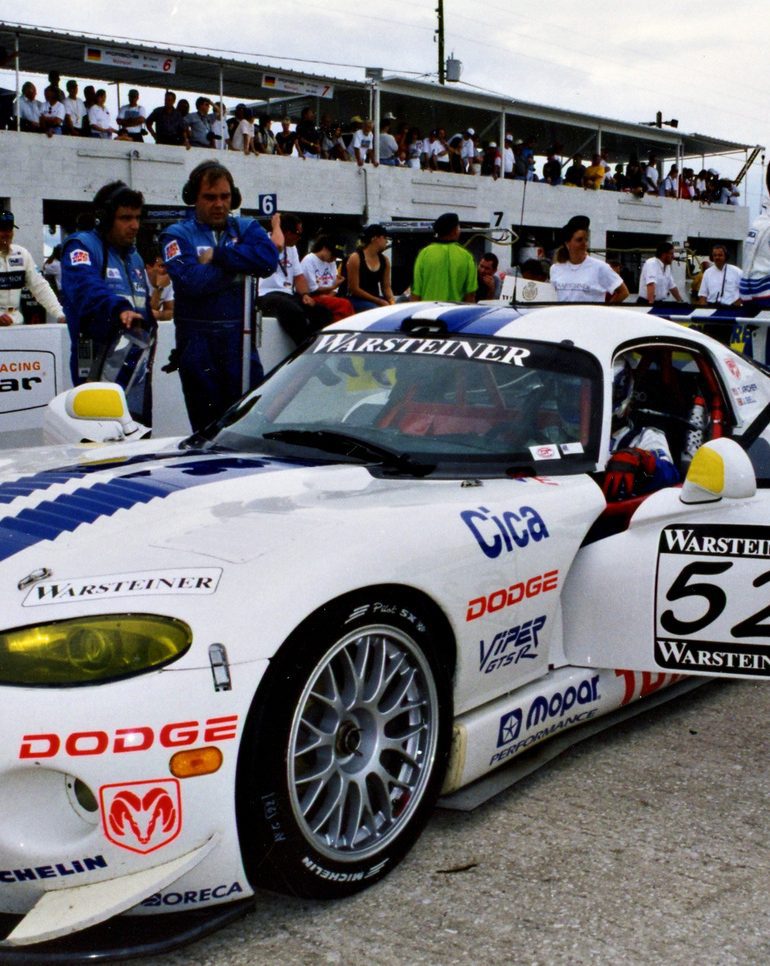1997→2000 Chrysler Viper GTS-R
When the Team Oreca’s Viper program switched from GT1 to GT2 racing it became one of the most successful race cars of the late 1990s. It won the FIA GT2/GTS World Championship in 1997, 1998 and 1999 as well as Le Mans class victories in 1998 and 1999.
The Viper was developed by Viper Team Oreca in France. They sourced a chassis from Reynard Motorsport in the UK and fabricated a body that mimicked the production car with an added wing diffuser and front splitter.
Racing
In 1997 Team Oreca Viper entered the car in the first FIA GT Championship and won 6 of 11 races to take the championship. The success continued in 1998 with a total dominance of the FIA GT Championship. At Le Mans the Viper Team Oreca finished 1-2 in the GT1 class ahead of the Roock Racing Porsche 911 GT2. During this time Oftedahl Motorsport also achieved six class wins in the British GT Championship.
For 1999 the effort was ramped up for a two-car team in the ALMS season which was also quite successful. Again Oreca took the FIA GT Championship with Chamberlain Racing right behind. At Le Mans the 1-2-3-4 sweep of the GT2 class made the Viper the car to beat.
In 2000 the FIA GT Championship was left for privateer efforts which resulted in losing the season to the Lister Storms. Oreca continued with the ALMS and won the season despite heavy pressure from the factory Corvettes.
Beyond 2001 the Viper program was officially over, but eight private teams in the FIA GT Championship chose the GTS-R including Larbre Compétition who won the Proximus 24 Hours of SPA and the Championship outright. Larbre’s success continued in 2002. By 2003 the Viper was finally showing its age, especially in comparison to the Prodrive-built Ferrari 550.
Chrysler Viper GTS-R Gallery
In Detail
| type | Racing Car |
| production years | 1997 – 2000 |
| built at | Le Mans, France |
| coachbuilder | Reynard Motorsport |
| production | 52 |
| predeccesor | 1995 Chrysler Viper GTS-R GT1 |
| succeccesor | 2003 Dodge Viper SRT-10 Competition |
| engine | 356-T6 90º V10 |
| position | Front, Longitudinal |
| aspiration | Natural |
| valvetrain | OHV 2 Valves / Cyl |
| fuel feed | Electronic Fuel Injection |
| displacement | 7986 cc / 487.34 in³ |
| bore | 101.6 mm / 4.0 in |
| stroke | 98.5 mm / 3.9 in |
| compression | 12.0:1 |
| power | 462.3 kw / 620 bhp @ 6500 rpm |
| specific output | 77.64 bhp per litre |
| bhp/weight | 539.13 bhp per tonne |
| torque | 800 nm / 590.0 ft lbs @ 5300 rpm |
| body / frame | Body over Steel Spaceframe Chassis |
| driven wheels | RWD |
| front brakes | Ventilated Steel Discs |
| rear brakes | Ventilated Steel Discs |
| f suspension | Double Wishbones |
| r suspension | Double Wishbones |
| curb weight | 1150 kg / 2536 lbs |
| transmission | Borg Warner T56 6-Speed Manual |




